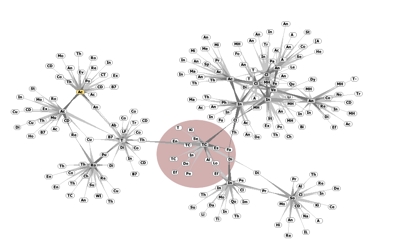Using HubMed's 'Rank Relations' to focus down multiple related articles, I'd produced this list of papers (stored in biologging). To my mind, they're all on a similar topic, but PubMed's 'Related Articles' feature, based on shared keywords, had not created strong links (ie in the first 20 results) between some of the more disparate papers. The graph below is basically a graphical representation of 'Rank Relations', made by sending the IDs from the list to a TouchGraph. One main cluster is obvious in the top-right, but the other papers are only linked to that cluster indirectly, making it hard to break out of that cluster and into other interesting, similar areas.
One way of jumping across those cluster boundaries could be to use Seb Paquet's proposal for Navigable Synthesis Ontologies, where people can use a wiki to manually create links between subject areas they consider to be related despite varied vocabularies. This would also include parent/child hierarchies, to make browsing easier.
Alternatively, as I said before, the more topic-specific lists are made and stored in biologging, the easier it will be to use those cross-boundary collections to find other similar papers that wouldn't be found by straightforward shared keyword searching. Also, anyone who keeps a weblog of papers related to their specialist subject will provide an excellent cross-category resource for newcomers.
